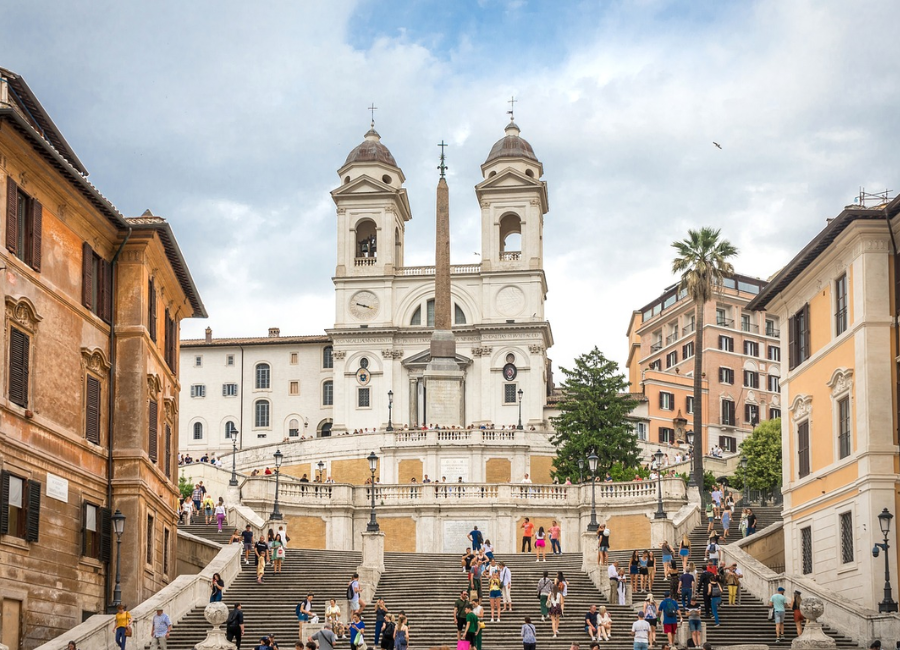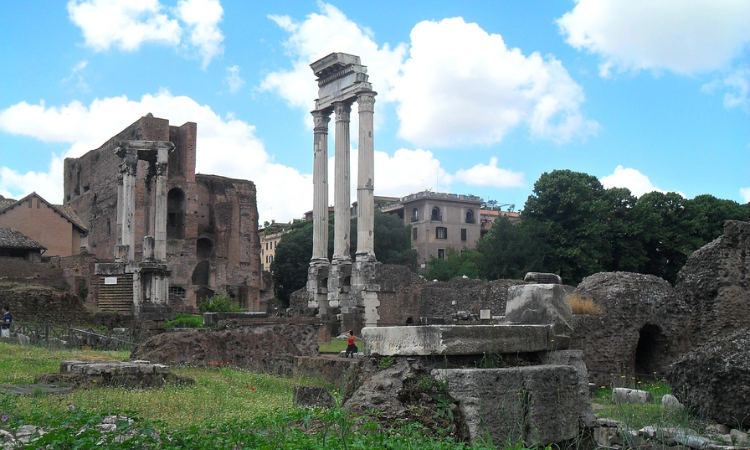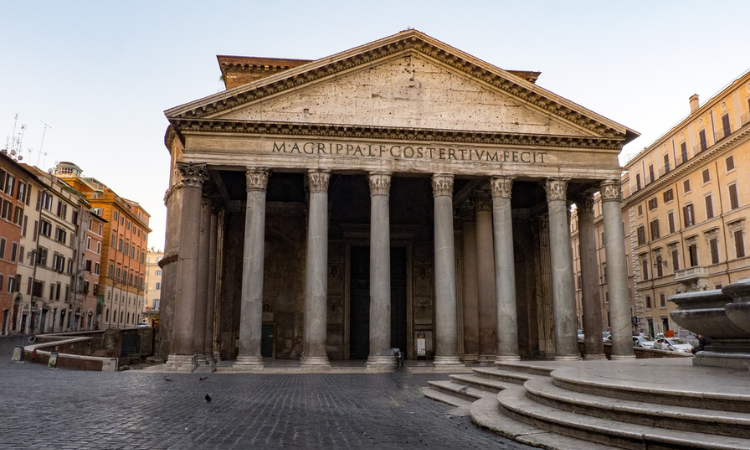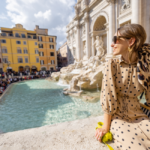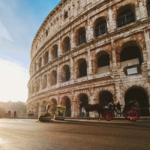Rome, the eternal city immersed in its historical tapestry, stands as a living testament to the magnificence of the Roman Empire. The echoes of its illustrious past reverberate through the cobblestone streets and enduring architectural wonders. As we venture through Roman ruins on Italy tours, our focal point is the vestiges of an era that indelibly shaped the trajectory of history—the Roman Empire.
During its zenith, the Roman Empire stretched across vast territories, leaving an indelible imprint on cultures, governance, and architecture throughout Europe, Asia, and Africa. From its mythical inception in 753 BC to its zenith around 117 AD, Rome played a central role in shaping the ancient world. The remnants of this formidable empire, encapsulated in the form of the best Roman monuments, act as portals to a bygone era.
Exploring Roman ruin is akin to unlocking a time capsule, affording us a peek into the daily lives, cultural opulence, and architectural mastery of ancient Rome. Scattered throughout the city, these remnants house tales of triumphs, defeats, and the mundane routines of a civilization that etched an enduring mark on human history.
The Grandeur of the Roman Forum
The Roman Forum, one of the most popular landmarks in Italy and UNESCO World Heritage Sites, located at the core of ancient Roman civilization, took shape as a large rectangular plaza surrounded by vital city structures. Beyond being just a meeting point, it served as the central hub for political, legal, and social activities in Ancient Rome. Unlike other forums, it became the primary public space hosting significant events like military triumphs, gladiatorial spectacles, trials, and influential speeches.
More than a backdrop, the Forum housed the Senate, governing the Roman Republic and later the Roman Empire, making it the focal point of Rome’s political life until the empire’s decline. Structures like courthouses, temples, and monuments played crucial roles in daily city life and its citizens’ spiritual practices.
Today, the Roman Forum, part of the same ticket as the Colosseum and Palatine Hill, invites visitors into a world of historical grandeur and architectural wonders. Prominent structures like the Temple of Saturn and the Basilica of Maxentius still stand as enduring symbols of Rome’s magnificence. Some are well-preserved, while others exist as poignant fragments, evoking awe.
Visiting the Forum feels like a journey through time, especially with a knowledgeable guide. Roaming this historical landscape immerses you in antiquity, allowing you to envision Ancient Rome through its inhabitants’ eyes. It’s arguably the best place in the modern city to connect with its ancient roots authentically, standing as a timeless testament to Rome’s enduring legacy.
Historically, the Roman Forum, one of the most beautiful Italian landmarks, constructed in the 7th century BC, evolved into the epicenter of Roman life. Initially a marketplace, it transformed into a hub for political and religious activities, witnessing triumphal processions, debates, and ceremonies. The Forum played a crucial role in pivotal moments of Roman history, reflecting the empire’s rise and fall, the shaping of laws, and the daily pulse of life.
Representing various aspects of Roman society, the Roman Forum’s architectural marvels, like the Temple of Saturn and the Basilica Julia, showcase the empire’s political prowess. Simultaneously, structures like the Curia Julia stand as silent witnesses to the political debates that shaped the empire’s fate.
Palatine Hill – Witness to Rome’s Legendary Beginnings
The Palatine Hill, another among the list of ancient Roman ruins, weaves a rich tapestry blending myths and concrete history. Legend tells of its role as the cradle of Rome’s founders, Romulus and Remus, with the “Hut of Romulus,” an Iron Age structure, perched on the southwestern summit. Revered across generations and meticulously restored, this structure remains a tangible link to Rome’s foundational lore, visible in the hill’s archeological layers.
Beyond the realm of fables, archaeological findings indicate human habitation dating back to the 10th century BC, predating Rome’s traditional founding. Livy, the esteemed Roman historian, positioned the Palatine as the nesting place of the city’s earliest settlers, elevating it to historical and cultural aristocracy within Ancient Rome’s urban landscape.
The Palatine’s allure transcends mythology, encompassing its prime urban location, panoramic views, cooler summer temperatures, and fresher air compared to the bustling city below. During the Republican period, opulent villas owned by Rome’s elite dotted its landscape. In the Imperial era, emperors like emperor Augustus, Tiberius, and Domitian chose it as their residence, giving rise to majestic ruins like the Flavian Palace, the Stadium of Domitian, and the House of Augustus. However, grand structures like the Temple of Apollo and the ornate Septizodium have faded into obscurity, leaving scant evidence of their past splendor.
Through the Middle Ages, new chapters were woven into the Palatine’s story, marked by the rise of churches and convents amidst its ruins. In the Renaissance, the influential Farnese family transformed a section into lavish botanical gardens. Following periods of activity, the Palatine slumbered until its awakening as the profound archaeological site recognized today—a palimpsest of Rome’s continuous evolution.
Discovering Myths and History:
Palatine Hill, a widely known landmark in Italy, enveloped in legends and steeped in history, plays a crucial role in the legendary beginnings of Rome. According to ancient tales, this iconic hill is where the mythical she-wolf nursed Romulus and Remus, the legendary founders of Rome. Beyond the myths, Palatine Hill holds a rich historical tale, marking the location where Rome’s elite opted to establish their residences.
Significance in Ancient Roman Times:
At the peak of the ancient city Rome, Palatine Hill transformed into an esteemed residential area, hosting the luxurious homes of emperors, aristocrats, and influential figures. It became a symbol of prestige and authority, overlooking the Roman Forum and the Circus Maximus. The magnificence of its palaces and lush gardens reflected the wealth and influence of those who lived on the hill.
What Today’s Visitors Can Explore:
Currently, Palatine Hill offers a captivating journey through time for visitors. Exploring its well-preserved ruins allows one to imagine the extravagant lifestyles of ancient Rome’s elite. The Domus Augustana, the House of Livia, and the Stadium of Domitian are some of the archaeological treasures that transport visitors to an era of imperial grandeur.
The Might of the Colosseum
The Colosseum, also known as the Flavian Amphitheater, stands as a vast amphitheater in Rome, commissioned as a gift to the Roman people during the reign of the Flavian emperors. This is one of the most popular Italian landmarks.
Construction of the Colosseum commenced between C.E. 70 and 72 under Emperor Vespasian, with its grand opening nearly a decade later. Over the following years, it underwent multiple modifications. The colossal structure measured approximately 189 by 156 meters (620 by 513 feet), towering four stories high, featuring a remarkable eighty entrances—seventy-six for patrons, two for event participants, and two exclusively for the emperor. This multitude of entrances was essential, given the Colosseum’s staggering maximum capacity of over 50,000 spectators.
Upon its inaugural opening, Emperor Titus marked the occasion with a hundred days of gladiatorial games, a tradition continued by subsequent emperors. Emperor Commodus notably participated in the arena extensively. Beyond gladiatorial combat, the Colosseum hosted diverse events, including dramas, reenactments, and public executions.
As time progressed, Roman interest in the games waned, leading to the Colosseum’s neglect and deterioration after the fall of the Western Roman Empire. Earthquakes in the fifth century C.E. further damaged the structure. By the 20th century, nearly two-thirds of the original edifice had succumbed to decay. However, a restoration initiative launched in the 1990s revitalized the Colosseum, making it one of Rome’s foremost modern-day tourist attractions, welcoming millions of visitors annually.
History and Architecture:
The Colosseum, officially known as the Flavian Amphitheater, stands as an immortal symbol of Roman engineering and grandiosity. Constructed under the Flavian dynasty, its completion in 80 AD marked an era where architectural marvels embodied the might of the Roman Empire. This colossal amphitheater, with its ingenious use of arches and columns, is a testament to the advanced engineering prowess of ancient Rome. This is one of the most interesting Italian landmarks.
Use for Gladiator Fights:
The Colosseum was the epicenter of unparalleled spectacles, primarily hosting gladiator fights that captivated the Roman populace. Gladiators, often prisoners or slaves, engaged in fierce combat within the arena, showcasing martial skills and courage. The blood-soaked sands of the Colosseum bore witness to intense battles, creating an enduring legacy that reverberates through history.
Symbol of the Roman Empire:
Beyond its function as an arena for bloodsport, the Colosseum emerged as a potent symbol of the Roman Empire’s dominance. Its monumental structure served as a visual manifestation of Rome’s power, embodying the grandeur and authority of the imperial capital. The Colosseum’s iconic presence in the cityscape became synonymous with the strength and cultural prowess of the Roman civilization. So are you ready to explore one of the most famous Sculptures in Rome?
Ostia Antica – A Peek into Ancient Roman Life
Another on thelist of historical sites in Rome is- Ostia Antica. Once a bustling seaport of ancient Rome, it now lies in splendid ruins near modern-day Rome. Stepping into the past, you can immerse yourself in the lively history of this once-thriving city. Walk along the well-preserved ancient streets, admire the grandeur of ancient temples, and marvel at Roman mosaics telling tales of ancient times. Ostia Antica’s archaeological site is a unique opportunity to connect with the captivating history of the Roman Empire.
Theater of Ostia Antica:
The ancient Theater of Ostia Antica, with its unparalleled grandeur, was a venue for entertaining the citizens of Rome. Stand in the middle of this remarkable amphitheater and imagine the echoes of applause and laughter that once filled the air.
The Forum Baths:
The Forum Baths in Ostia Antica are ancient public baths offering a glimpse into Roman communal life. These well-preserved ruins showcase Roman engineering sophistication, featuring various rooms for different bathing practices. Wander through the complex and picture the vibrant social scene that once thrived within its walls.
Caseggiato del Thermopolium:
Explore the ancient Roman equivalent of a fast-food restaurant at the Thermopolium. Discover the counter where locals and travelers dined on ready-to-eat meals and see the well-preserved frescoes on the walls of this ancient eatery.
Nestled along the Banks of the Tiber River:
Strategically located along the picturesque banks of the Tiber River, Ostia Antica emerges as a captivating time capsule, inviting modern explorers to uncover the secrets of ancient Roman life. This carefully preserved harbor town stands as a testament to the enduring legacy of a once-thriving port city, offering a unique and immersive journey into antiquity.
The Bustling Port City:
In its prime, Ostia Antica was more than a town; it was a bustling port city intricately connected to the pulse of ancient Rome. The rhythmic flow of trade, commerce, and cultural exchange echoed through its cobbled streets, creating a vibrant tapestry of life along the riverbanks.
Archaeological Treasures and the Complexity of Bygone Era:
Ostia Antica’s archaeological treasures serve as gateways to the past, revealing the complexity and richness of an ancient era. As visitors wander through the remarkably preserved streets, intricate mosaics underfoot tell stories of craftsmanship and artistic expression. Remnants of temples and theaters, once alive with the echoes of performances and rituals, stand as silent witnesses to the cultural tapestry woven by ancient Romans.
Preservation of Ancient Roman Urban Planning:
Ostia Antica stands as a marvel of meticulous preservation, showcasing the brilliance of ancient Roman urban planning. The carefully laid-out streets, adorned with remnants of grandeur, evoke a sense of awe. The city’s layout testifies to the deliberate organization of spaces, revealing areas dedicated to commerce, residential quarters, and communal activities. This meticulous planning provides invaluable insights into the social dynamics and daily routines that shaped the lives of ancient Romans.
Hadrian’s Mausoleum – A Monumental Tomb
Throughout nearly 1900 years since its construction in the 2nd century AD, this structure has undergone numerous transformations in its role and purpose, much like many other ancient sites and monuments in Rome. Originating as an imperial mausoleum, it became part of the city walls’ defensive structure. Subsequently, it evolved into a fortress and papal residence, served as a military barracks, and functioned as a prison. Presently, it stands as a national museum.
History and Architecture:
Hadrian’s Mausoleum, a monumental testament to imperial grandeur, stands as a revered structure in the heart of Rome. Commissioned by Emperor Hadrian in 135 AD as a final resting place for himself and his successors, the mausoleum boasts a rich history intertwined with the architectural brilliance of ancient Rome. The structure’s imposing cylindrical form and strategic location along the Tiber River contribute to its commanding presence in the city’s skyline.
Significance to Emperor Hadrian:
Hadrian’s Mausoleum, a renowned landmark in Rome, encapsulates the profound significance Emperor Hadrian placed on commemorating his legacy. Beyond serving as a tomb, it symbolizes Hadrian’s vision of eternal remembrance and the enduring power of the Roman Empire. The mausoleum’s design, inspired by the classical aesthetics of Greek architecture, reflects Hadrian’s appreciation for cultural and artistic pursuits.
Link to Roman Architecture:
As an exemplar of Roman architecture, Hadrian’s Mausoleum showcases the mastery of engineering and design prevalent during the empire’s peak. The use of concrete and the incorporation of classical elements, such as the Doric frieze and Corinthian pilasters, exemplify the fusion of innovation and tradition. The mausoleum’s towering presence pays homage to the Romans’ penchant for monumental structures that transcended mere functionality, embodying the eternal spirit of the empire.
The Pantheon – Rome’s Architectural Marvel
The Pantheon stands as one of the most well-preserved Rome monument. Constructed around 126-128 A.D. during Emperor Hadrian’s rule, it boasts a rotunda with an expansive domed ceiling, holding the record as the largest of its kind during its construction. This architectural marvel occupies the site of an earlier structure, dating back to 25 B.C., credited to statesman Marcus Agrippa and likely intended as a temple for Roman deities.
Numerous mysteries shroud the Pantheon’s history, including uncertainties about its designer and the duration of its construction, given the absence of written records.
The Pantheon’s design has left an indelible mark, influencing countless structures worldwide, spanning Europe to the Americas. Today, the Pantheon serves as both a church and a prominent tourist attraction.
History and Architectural Design:
The Pantheon, a crowning jewel of Rome’s architectural heritage, boasts a storied history and an unparalleled design that continues to captivate visitors. Originally commissioned by Marcus Agrippa in 27 BC and later rebuilt by Emperor Hadrian around 120 AD, the Pantheon stands as a testament to ancient Roman engineering prowess. Its iconic dome, considered the largest unreinforced concrete dome in the world, showcases a harmonious blend of classical and innovative architectural principles.
Role in Ancient and Modern Rome:
The Pantheon’s legacy transcends time, playing a pivotal role in both ancient and modern Rome. In its early days, it served as a temple dedicated to the Roman gods, a purpose reflected in its name, derived from the Greek words “pan” (all) and “theos” (god). The grandeur of the Pantheon’s architecture and its celestial oculus, an opening in the dome allowing natural light to filter through, created an awe-inspiring sacred space.
In modern times, the Pantheon has adapted to new roles, evolving from a place of worship to a symbol of architectural excellence. Its dome remains an engineering marvel, inspiring architects and visitors alike. The Pantheon’s enduring significance is also evident in its transformation into a Christian church, Santa Maria ad Martyres, reflecting the adaptive nature of Rome’s historical sites.
Beyond the Main Attractions – Lesser-Known Roman Ruins
Introducing Other Significant but Lesser-Known Ruins:
While Rome’s iconic landmarks draw global attention, the city harbors a treasure trove of lesser-known Roman ancient ruins that unveil hidden chapters of its history. Journeying beyond the main attractions, we discover captivating sites that provide unique insights into ancient Roman life and culture.
The Baths of Caracalla:
The Baths of Caracalla, an expansive complex built in the 3rd century AD, stand as a testament to the Romans’ penchant for grandeur. These public baths, capable of accommodating thousands of visitors, reflect the opulence and social aspects of Roman bathing culture. Despite their lesser-known status, the Baths of Caracalla showcase remarkable architectural feats and the scale of communal life in ancient Rome.
Circus Maximus:
Circus Maximus, often overshadowed by the Colosseum, once served as Rome’s premier venue for chariot races and public spectacles. Spanning a vast expanse, this ancient stadium could host up to 150,000 spectators. Exploring Circus Maximus offers a glimpse into the thrill and excitement that defined public entertainment in ancient Rome, underscoring the multifaceted nature of the city’s leisure and recreational spaces.
Roman Catacombs:
Beneath the bustling streets of Rome lie the Roman Catacombs, intricate networks of underground burial chambers. Often overlooked, these subterranean passages reveal a fascinating aspect of Roman religious and burial practices. The catacombs, such as those along the Appian Way, served as resting places for Christians and offered a unique perspective on the city’s religious diversity and social dynamics.
Planning Your Visit to Rome’s Ruins
Practical Tips for Visiting Rome’s Ruins:
Embarking on a journey through Rome’s historic ruins demands thoughtful planning to maximize the richness of your experience. Here’s an elaborate guide to ensure you navigate the ancient and modern intricacies of this timeless city with ease:
1. Optimal Timing for Tranquil Exploration:
- Plan your visits during early mornings or late afternoons to avoid the peak crowds. This strategic timing not only allows for a more peaceful exploration but also enhances the ambiance, providing a serene backdrop to absorb the historical significance of each site.
2. Guided Tours for In-Depth Understanding:
- Engage in guided tours led by knowledgeable experts. These tours offer a deeper understanding of the historical context and architectural marvels of Rome’s ruins. Guides provide valuable insights, anecdotes, and context that enhance your overall appreciation of the sites. Consider selecting specialized tours based on your interests, whether it’s archaeology, art, or ancient history.
3. Advance Booking and Skip-the-Line Options:
- For renowned sites like the Colosseum and Roman Forum, consider booking tickets in advance. This not only saves time but also ensures you have guaranteed access to these iconic landmarks. Explore skip-the-line options for a more seamless and efficient visit, allowing you to focus on the historical wonders rather than waiting in queues.
4. Comfortable Attire and Essentials:
- Given the extensive walking involved, wear comfortable footwear. Rome’s weather can vary, so dress in layers and carry essentials like sunscreen and water to stay comfortable throughout your explorations. A hat and sunglasses are also advisable for sun protection.
5. Respectful Behavior and Mindful Photography:
- Maintain a respectful demeanor at these historical sites. Avoid touching or leaning on ancient structures, and be mindful of the importance these ruins hold for both locals and global visitors. Practice responsible photography by adhering to designated areas and avoiding the use of flash, ensuring the preservation of these timeless treasures.
Suggested Itineraries for Experiencing the Ruins:
Crafting a well-rounded itinerary ensures a comprehensive and enriching exploration of Rome’s ruins. Here’s a detailed guide to capturing the essence of the city’s historical marvels:
1. Central Rome Discovery:
- Begin your journey in central Rome, exploring iconic sites like the Colosseum, Roman Forum, and Pantheon. This central hub offers a concentrated dose of ancient wonders, showcasing the heart of the city’s historical legacy.
2. Hidden Gems Expedition:
- Venture beyond the well-known sites to discover hidden gems such as the Baths of Caracalla and Circus Maximus. These lesser-explored locations provide a more intimate and authentic connection to ancient Roman life.
3. Underground Exploration:
- Dive into the subterranean marvels of the Roman Catacombs. Explore the labyrinthine passages and chambers that unveil the diverse religious history of ancient Rome, offering a unique perspective on burial practices and spiritual traditions.
4. Evening Strolls in Ancient Times:
- Experience the ruins during the enchanting evening hours. Select a few sites for an evening stroll, allowing you to witness the play of light on ancient structures and create a magical ambiance that echoes the splendor of ancient times.
By incorporating these detailed practical tips and suggested itineraries into your visit, you’re poised to uncover the layers of history that define Rome—a city where each ruin tells a tale of a bygone era. Enjoy your exploration of this timeless tapestry of antiquity!
Conclusion
Embarking on a journey through Roman ruins when you visit Rome is not just a stroll through ancient remnants but a profound exploration of history etched in stone. As you traverse the hallowed grounds of the Colosseum, Roman Forum, Pantheon, and lesser-known gems like the Baths of Caracalla and Circus Maximus, each step unveils a chapter of a civilization that shaped the course of human history.
Summarizing the Experience:
Rome historical sites bear witness to the grandeur of a bygone era, reflecting the political, social, and religious fabric of ancient Rome. From the architectural marvels of the Colosseum to the intricate streets of the Roman Forum, each site narrates a tale of triumphs, struggles, and the daily life of a vibrant society. The underground mysteries of the Roman Catacombs add a spiritual dimension, connecting visitors with the diverse religious practices of ancient Romans.
Importance in Understanding History:
Exploring Roman ruins is not merely a visual spectacle but a tangible link to a rich tapestry of human civilization. These sites serve as living textbooks, offering insights into governance, cultural expressions, and the resilience of a society that thrived for centuries. The ruins provide a visceral connection to historical events, fostering a deep understanding of the complexities and achievements of ancient Rome.
Encouragement to Explore:
To grasp the essence of history truly, one must walk the same paths that ancient Romans once tread. The call to explore these sites resonates not just as a tourist endeavor but as a pilgrimage to connect with our collective past. Whether it’s the iconic Colosseum or the hidden corners of the Roman Forum, each step is an opportunity to immerse oneself in the echoes of an empire that shaped the Western world.
In the heart of Rome’s ruins, the stones whisper tales of triumph, echo with the voices of emperors, and carry the weight of centuries. As visitors navigate this open-air museum, they become time travelers, bridging the gap between antiquity and the present. The ruins are not relics of a bygone era; they are gateways to understanding, a tangible testament to the enduring legacy of Rome. So, let the ancient stones speak, and may your exploration of Roman ruins be a journey that transcends time itself.
If you need any help in planning your trip to Italy or travel to Italy by rail, reach out to our experts and they will take care of it.
FAQ Section: Top Questions About Roman Ruins in Rome
1. What Are the Must-See Roman Ruins in Rome?
Answer: The must-see Roman ruins in Rome include the Colosseum, known for its grandeur and gladiatorial history; the Roman Forum, once the center of Roman public life; Palatine Hill, rich in myths and historical significance; the Pantheon with its remarkable architecture; and Ostia Antica, offering a glimpse into everyday life in ancient Rome. Each of these sites provides a unique insight into the Roman Empire and its legacy.
2. How Much Time Should I Allocate for Visiting Roman Ruins?
Answer: It’s recommended to allocate at least half a day for major sites like the Colosseum and Roman Forum. For a comprehensive exploration, including lesser-known ruins, you might need two to three days. Consider guided tours for in-depth understanding and efficient time management.
3. Are There Entry Fees for the Roman Ruins, and Can I Buy a Combined Ticket?
Answer: Many Roman ruins, like the Colosseum and Roman Forum, require entry tickets. You can purchase individual tickets for each site or a combined ticket for convenience and cost savings. Prices and availability can vary, so it’s advisable to check the official websites or contact local tourist information centers for current details.
4. What is the Best Time of Year to Visit Roman Ruins in Rome?
Answer: The best time to visit Roman ruins in Rome is during the spring (April to June) and autumn (September to October). These periods offer pleasant weather, fewer crowds, and more comfortable exploration of outdoor sites. Summers can be hot and crowded, while winters are quieter but with shorter visiting hours.
5. Are the impressive Roman Ruins Accessible for Visitors with Mobility Issues?
Answer: Accessibility varies across different ruins. The Colosseum has lifts and ramps for wheelchair access, but sites like the Roman Forum and Palatine Hill have uneven terrain that might be challenging. It’s advisable to check the official websites or contact the sites directly for detailed accessibility information and available facilities.
 Toll Free (USA & Canada) +1 866 978 2997
Toll Free (USA & Canada) +1 866 978 2997


